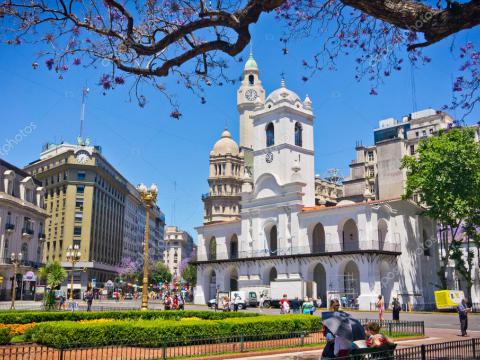Introducing Buenos Aires
In Spanish, Buenos Aires means "fair winds" or "good airs." The official name is Ciudad Autónoma de Buenos Aires, but it is also known as Capital Federal ("Federal Capital"). It is one of the largest cities in Latin America, with a diverse cultural offering, and serves as a gateway to the rest of the world. People from Buenos Aires are known as porteños, which translates as "people from the port," since the city was built as a port to defend against pirates and other enemies. Buenos Aires is an accessible and inviting destination that allows visitors to experience not only the city but also an outstanding urban adventure.
The city is geographically contained within the province of Buenos Aires but is constitutionally autonomous.
The city sprawls over a plain that stretches 19.4 km (12.1 mi) north to south and 17.9 km (11.1 mi) east to west.
Buenos Aires (the Federal Capital of Argentina, with an area of 202 km2) is home to approximately three million people (78 sq mi). The city is divided into 48 districts, which are known as barrios (neighborhoods). With over 15 million inhabitants, it ranks among the top 30 most populous urban conurbations in the world, along with its metropolitan area known as Great Buenos Aires (Gran Buenos Aires). The bulk of Argentina's economic activity is concentrated in and around this single capital.
Buenos Aires welcomes visitors from all over the world and provides a diverse range of cultural activities, nightlife, restaurants, and bars, all of which provide excellent service.
Buenos Aires has one of the largest LGBT populations in Latin America. The city has a positive outlook toward LGBT culture. In Argentina, same-sex partnerships are legal and recognized. There are several LGBT-friendly businesses in the area, including some in the tourism industry. There are, for example, travel agencies, numerous classes and nightlife activities, as well as LGBT-friendly lodging. Gay cruise ships and even a gay five-star hotel are available.
The Spanish spoken in Buenos Aires differs from that of the rest of the Spanish-speaking world. Most notably, the ll sound in "calle" and "pollo" sounds like the English sh. Many of the words that porteños pronounce differently than the rest of the Spanish-speaking world are pronounced identically to an Italian word for the same thing, which indicates the presence of Italian merchants in the port in the nineteenth century.
In Buenos Aires, much has been written about the Spanish language. It was influenced by the many different nationalities that immigrated here, especially Southern Italians.
These variations would be obvious to everyone who has learned Spanish. Furthermore, vocabulary varies significantly from that of Iberian Spanish and other Latin American varieties of Spanish. So, before visiting Buenos Aires, it would be a good idea to get an Argentinian dictionary or take some Argentinian Spanish lessons. Despite these gaps, someone who speaks Spanish fluently should have no trouble conversing with porteños or other Argentinians. In any case, most "porteños" (Buenos Aires City residents) speak a little English, but it is very easy to find people who are very fluent, particularly if you stay near the tourist areas.
Last modified on 05/20/2021 - 07:08
Places 0
Currently there are no places in Buenos Aires.
Articles 0
Currently there are no articles about Buenos Aires.
Trip reports 1
Videos
Currently there are no videos of Buenos Aires.



